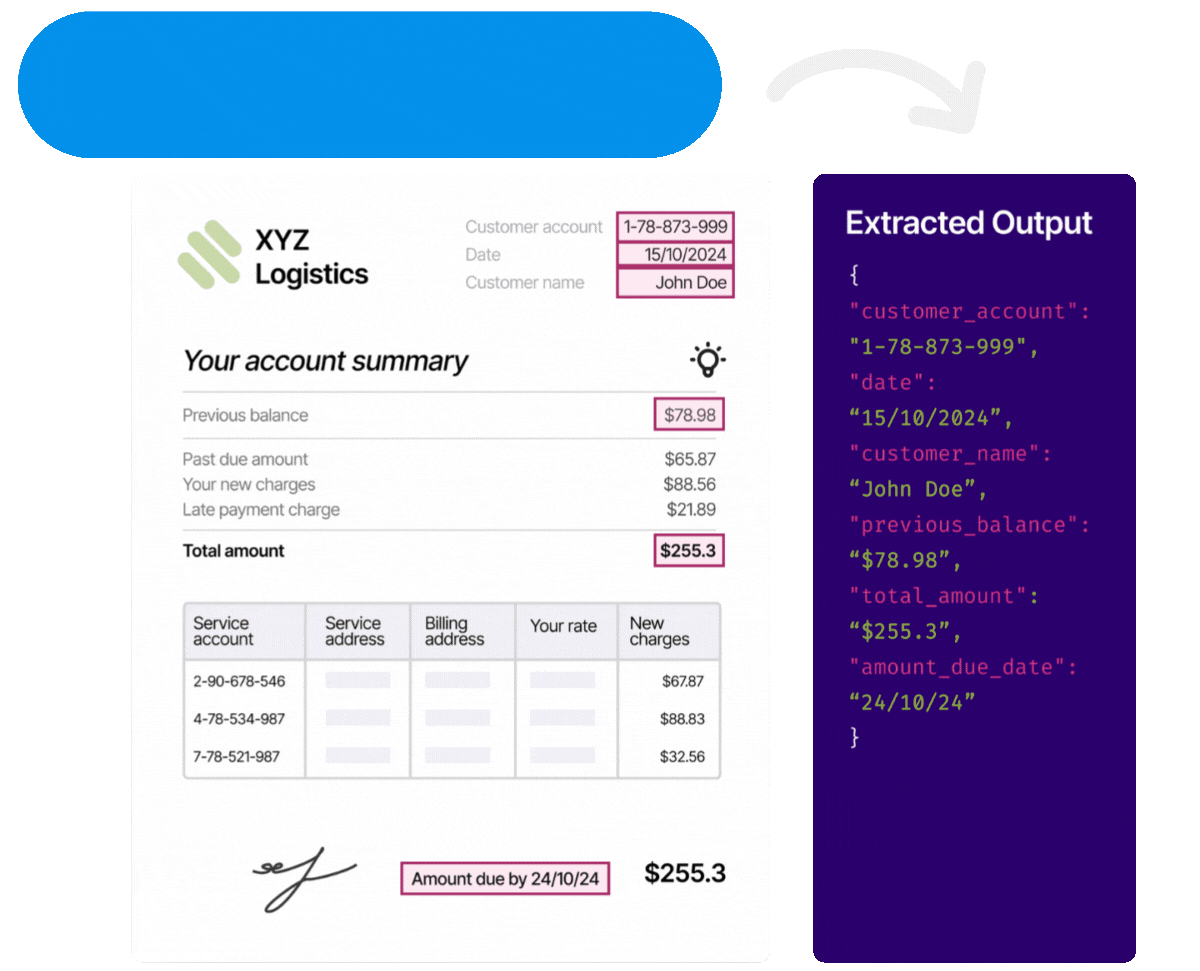How to extract data automatically from structured and unstructured documents with 99.97% accuracy in seconds with Extract AI?

Introduction
A common issue across industries is extracting key data accurately from online documents, printed paper or images. Let’s consider banks. Each day, bankers pull data such as pay frequency from payslips or customer and bank details from invoices. They do this to validate customer and bank details to ensure accuracy.
In addition, lending involves processing thousands of documents every day. Therefore, human error is inevitable. Furthermore, lengthy copy-and-paste tasks delay approvals and drive inefficiency.
Therefore, we must examine document types and the specific data they contain. This highlights structured and unstructured data as the two file types vital to finance, legal, professional and healthcare sectors.
What is Unstructured Data? Understanding its Implications and Opportunities
Unstructured data makes up over 80% of all data within many organisations today (TechRepublic, 2024). This file type of data includes everything from customer emails and social media content to video and audio files. It also covers text files, content-based documents, images and more. Unlike structured data, which fits neatly into rows and columns, unstructured data requires advanced data analytics to unlock its value. With effective data management, companies can gain unprecedented insights, giving them a strategic edge in today’s data-driven world.
Contracts and Agreements
Financial Reports
Letters and Memos
Handwritten Notes
Audio and Video Files
Meeting Minutes
PDFs and Scanned Documents
Social Media Posts
Identity Document Images
Emails
and more
Types of unstructured data
What Makes Unstructured Data Different?
Unstructured data doesn’t conform to traditional relational database management systems (RDBMS), as it lacks a predictable format. Instead, it often appears as text-heavy documents, images, audio, or videos. In fact, research shows that businesses with advanced data analytics frameworks can see 10-15% higher productivity (McKinsey, 2023). By employing data modeling and advanced algorithms, companies can process unstructured data and extract actionable insights.
The Challenges of Managing Unstructured Data
Without the traditional structure, unstructured data requires innovative storage and management solutions. Conventional data storage formats often struggle with the variety and scale of unstructured data. This challenge necessitates data lakes or similar flexible storage systems for effective database management (Forbes, 2023). Data normalisation, database structure planning, and flexible database storage are key techniques that help streamline data to data transformations.
What are structured documents?
Structure documents are documents that follow an organised pattern such as reports, agreements, or other records. The most vital key components of this type of document include how it is formatted for clarity and compliance. Examples include – profit and loss statements, balance sheets, invoices, pay slips, reports, account statements, loan applications, and more. Proper structure ensures accurate information, facilitates analysis, and supports informed decision-making.

How Can You Extract Structured or Unstructured Data and Turn it into Value
The answer is simple – Extract AI.
Extract AI is an AI-driven solution that can extract data from structured or unstructured documents in seconds. Also, this solution tackles the persistent challenges of manual data extraction. Consequently, it saves financial institutions time, increases accuracy and reduces costly human errors. Our adaptive models extract structured and unstructured data without relying on document layouts, handling diverse formats and layouts automatically. Simply drag and drop your files onto the Extract AI platform. Then, extract thousands of documents and capture your key data in seconds.
Whether you need data from pay slips, mortgage deeds, bank statements or invoices, our OCR technology has you covered. It detects multiple fonts, calligraphy, handwriting and more.Extract AI can accurately extract key data from PDFs, JPGs, PNGs and TXTs. It also handles XLSX, DOCX, MP3, MOV, MP4 and other formats.
Extract AI’s model can extract specific phrases with context relation, keywords or phrases from files or key values. The speed of our automated data extraction boosts customer response times by up to 40x with no extra training needed. DoxAI’s custom-built extraction models are tailored to your business requirements, delivering the ROI you deserve by turning data into actionable insights with precision and ease. The out-of-the-box solution includes white-labelling options and more than 150 ready-to-use templates for finance, legal, education and healthcare. You can also add your own template in just a few clicks.
What are the Business Benefits of using DoxAI Extract AI?
80
%
Reduce operational costs by eliminating the need for frequent constant manual intervention.
40
x
Achieve faster customer response times with automated processing of large volumes of documents.
99.97
%
Experience accuracy in data extraction, significantly reducing errors compared to manual processes.
*Note that the benefits listed above are based on current client outcomes and may vary depending on your specific use case.
Case Study of a Leading Non-Bank Automotive Lender
Problem
A leading non-bank automotive lender previously relied on an offshore manual team to extract information from motor vehicle invoices for financing. This process was often time-consuming and prone to errors. To improve efficiency and accuracy, the lender needed a secure data extraction platform capable of automatically extracting meaningful data from vehicle invoices and directly integrating it into their payout system.
Solution
We implemented our AI-driven extraction API which securely automated the extraction of sensitive data from invoices. This data was processed automatically and ingested into their payment systems in JSON format with an impressive 99.97% accuracy streamlining the finance approval and payment stages.
85%
Reduction in error data accuracy rates.
95%
Faster than the manual extraction.
60%
Reduction in the operational costs
Get in Touch with Our Team
No waitlist. No long onboarding. Start using the new DoxAI Extract AI features today.
References
Forbes (2023). The Future of Data Lakes and Unstructured Data Management. Available at:
https://lakehouse.app/article/The_Future_of_Data_Lake_Trends_and_Predictions.html
Gartner (2022). Customer Satisfaction and Data Analytics. Available at:
https://www.gartner.com/en/marketing/topics/customer-experience
McKinsey (2023). Boosting Productivity with Advanced Data Analytics. Available at:
https://www.ibm.com/blog/unstructured-data-trends/
TechRepublic (2024). Understanding the Rise of Unstructured Data in Business. Available at:
https://www.datacenterknowledge.com/data-storage/data-lakes-unlocked-divisive-data-architecture-fuels-advanced-ai-analytics
TechTarget (2024). Revenue Growth and Data Analysis in Modern Enterprises. Available at:
https://ibagroupit.com/insights/data-lakehouses-vs-warehouses-and-lakes/

